To celebrate the fiftieth anniversary of the longest-running science-fiction show in the world, I’ll be taking weekly looks at some of my own personal favourite stories and arcs, from the old and new series, with a view to encapsulating the sublime, the clever and the fiendishly odd of the BBC’s Doctor Who.
The Ice Warriors originally aired in 1967.
It’s strange that the Jon Pertwee era tends to attract so much criticism for adhering so rigidly to formula, with Barry Letts and his team rigidly working within well-defined lines and trying hard to produce television that doesn’t suck. Outside of the political criticism of the Pertwee era, there’s a train of thought that suggests the show became a little too formulaic, a little too predictable, failing to really push its own boundaries, with a few scattered exceptions.
And yet the Patrick Troughton era was arguably just as much a slave to routine and formula. The Troughton era is defined by its “base under siege” stories, so massively influential that they’ve become a Doctor Who subgenre unto themselves. Episodes like Earthshock and The Almost People arguably serve as homages to the genre that peaked during the late sixties. Indeed, allowing for some measure of flexibility, six of the seven adventures in this season could be described as “base under siege” stories.
I can’t help but wonder if the destruction of so many Troughton-era stories has led many Doctor Who fans to become blinded by nostalgia reflecting on the era. The Tomb of the Cybermen is, after all, much more exciting as the sole surviving “base under siege” story of the fifth season than it as the first of six adventures loosely adhering to the same structure and conventions.
I feel the need to clarify here, that I am delighted to have any Doctor Who recovered at all. I’m glad to see classic episodes reconstructed using soundtracks, and I’m ecstatic to see The Enemy of the World and The Web of Fear recovered from Nigeria. I’m secretly holding out hope for the rumours and speculation suggesting that there might be more to come, even as the more sceptical part of my brain tries to mitigate that enthusiasm.
And, while the wiping of classic Doctor Who was an understandable mistake made by the BBC in an era before repeats or home media made it likely that anybody would want to watch Fury from the Deep again, it was also a grave loss to popular culture. Patrick Troughton is a serious contender for the title of “best actor to play the Doctor”, and he suffers disproportionately from the loss of the recordings; I’d argue that the audio recordings do a much better job capturing William Hartnell’s performance than they do Patrick Troughton’s work in the role, where the loss of footage is felt so much more keenly. (Consider Enemy of the World.)
However, despite all this, part of me suspects that the loss of so much footage has obscured the fact that Second Doctor stories could be painfully formulaic at times. Indeed, part of me wonders if the strange fetishisation of “base under siege” stories among certain segments of Doctor Who fandom is rooted in the fact that so many of those stories were lost. That same part of me suspects that they’d be a lot less appealing if they survived in numbers equivalent to, say, the historical stories.
It is also worth conceding that the “base under siege” description is occasionally a bit generic. There is room for a lot of variation on that particular theme. In fact, you could make a convincing argument that, in The Ice Warriors, the base in question is more “under siege” from the glaciers than from the eponymous Martians, at least for the first four episodes. Similarly, the London Underground hardly counts as a “base” in The Web of Fear, even if the episode uses it as such.
Still, there’s a clear pattern. The Doctor arrives at [place], interacts with a relatively isolated bunch of humans doing stuff (quite often investigating weird goings-on), and encounters predatory [threat] seeking to destroy or gain control of the human group. Bonus points if all that is just a stepping stone to world domination or beyond. You can really mix and match within that formula to create a Patrick Troughton story with remarkable ease:
| Place | Threat |
| Creepy Tombs | Ice Warriors |
| Space Station | Deadly Sea Weed |
| London Underground | Cybermen |
| Glacier Base | More Cybermen |
| Tibetan Monastery | More Bloody Cybermen |
| Moonbase | Yeti |
| Oil Rig | More Yeti |
And there’s nothing inherently wrong with that, except that I suspect it might become quite draining after a while. Watching The Tomb of the Cybermen, The Ice Warriors, Enemy of the World and The Web of Fear in quick succession, the similarity in formula between The Ice Warriors and The Web of Fear was occasionally too overwhelming.
Of course, on its own merits, The Ice Warriors is a pretty fine episode of Doctor Who, holding up remarkably well – albeit with some obvious blemishes. The episode is rather famous for introducing the Ice Warriors, a bunch of aliens who only appeared a few times over the seven years between 1967 and 1974. I suspect that nostalgia plays so role in the way that fandom seems so very fond of these monsters. Their return during the 50th anniversary year (in The Cold War) was a much-hyped event – as compared to the return of the Macra, for example.
To be fair, I can see some of the appeal of the Ice Warriors as a part of Doctor Who history. The Ice Warriors are Martians, and Martians are the very coolest (ha!) of aliens, the extraterrestrial visitor with the strongest anchoring in our popular consciousness. Space is so incredibly and impossibly vast that the hope of another life form existing on our closest planetary neighbour is quite appealing. It would certainly make it a lot easy to find them, particularly in the life time of anybody living on this planet.
It seems quite important that The Ice Warriors was produced shortly after the Mariner 4 probe afforded mankind its first close-up examination of Mars. The probe offered pretty compelling evidence that there is no life on that planet, shattering romantic notion of an over-populated universe. In fact, you can see that playing out in other Doctor Who stories of the time. Patrick Troughton, for example, would never have appeared in a show packed with so many diverse and surreal aliens as The Web Planet, for example. In Troughton stories, space is harsher and emptier and scarier.
The Ice Warriors plays to that, suggesting that maybe there isn’t life on Mars right now, but maybe there was, once upon a time. It’s a nice way of getting around the fairly bleak findings from the Mariner 4 probe, while playing to an enduring part of popular culture. It’s worth pointing out that the next story to feature the Ice Warriors, The Seeds of Death, plays up the idea of space as empty and boring – forecasting a surprisingly prescient future where mankind was mastered space flight, but just can’t seem to imagine any way it would be worth while.
That said, the Ice Warriors don’t really seem to work here. They lack the surreal messy beauty of the Yeti monsters as seen in The Abominable Snowmen and again in The Web of Fear. Instead, they lumber around like men in silly cardboard suits, shuffling awkwardly and occasionally seeming like they might knock over the scenery. I’m not sure if the decision to present Martian “little green men” as giant lumbering black-and-white monsters is a work of genius or a misstep.
The Ice Warriors endured however, and I’d argue that the most successful use of the creatures came in their first colour appearance with Jon Pertwee, The Curse of Peladon – where they audience was expected to assume they were villainous because they were monsters that had appeared previously. In a brilliant twist, the Ice Warriors were presented as an honest and decent alien species, immediately distinguishing them from recurring foes like the Daleks or the Cybermen or the Autons or the Great Intelligence. The Ice Warriors were the aliens who weren’t inherently evil. Naturally, this interesting approach was fairly quickly reversed in The Monster of Peladon.
It’s worth noting that, despite the fact they’ve become on of the small group of enduring Doctor Who monsters, the Ice Warriors were not designed as a recurring foe. Brian Hayles suggests that the creatures were subject to the whims of fate, managing to be both lucky (in that they were reused later in the Troughton era) and unlucky (in that they were brushed aside by later production teams):
The Ice Warriors were never intended to return (after their first appearance), but I think at some stage it was decided to try them out again as possible recurring villains. I think there would have been more stories featuring them, had it not been for the big change when Pat Troughton left. Barry Letts and Terrance Dicks came in and wanted to get away from the past, which I think was a very wise move. I was very surprised when they decided to bring them back after a few years.
I’m still not a huge fan of the Ice Warriors, even if I love some of the ideas here. I wouldn’t rank them among the most effective or most enduring foes of the Troughton era, and I’ll concede that I’m surprised they made a full-colour appearance long before the Yeti. That said, I suppose that using them as green men from Mars was a hook too good to pass up.
The Ice Warriors is very well constructed. There’s something decidedly science-fiction B-movie about the whole thing, from the haunting introductory music, played on a wailing Theremin, to the plot device of “I found something in the ice, let’s take it back to base and defrost it” plot. While the Ice Warriors design seems to make movement very difficult for the actors inside the suits, the rest of the serial’s production design is quite wonderful. The black-and-white swirly jump suits just scream “sixties!” in the most endearing way possible, and the base set looks quite impressive.
That said, The Ice Warriors does feel like its drawn in the broadest manner possible. The characters don’t seem real, appearing more as broad archetypes that exist on a particular scale. Leader Client places too much faith in computers, and so must learn to engage with his humanity. Storr is a broadly-drawn Luddite, who is promptly killed off near the end of the fourth episode so the audience understands that the Ice Warriors are bad news.
Even the TARDIS crew seems to be drawn in the most generic of ways. Victoria is thrust so completely into the role of “screaming companion” that her cries threaten to cause avalanches. The Doctor stresses repeatedly that he doesn’t like computers, explaining that he works completely independently – as if the show is afraid that the audience might forget it if it isn’t brought up often enough. “Your regulations do not apply to me,” he assures Client in one of the more overt examples. “I work in my own way, freely.”
The conflict between the Doctor and Client is fairly clear from the first scene the two spend together, but The Ice Warriors feels the need to repeatedly clobber us over the head with it. Similarly, Troughton is perfectly capable of communicating the Doctor’s dislike of computers without being forced to offer such bland summary of the episode’s themes as “I do think you might try trusting human beings instead of computers.” Nuance is not The Ice Warriors‘ strong suit.
And yet, that’s almost the appeal of the story. The serial’s first line of dialogue informs us quite bluntly that this is going to be a story of a base under siege. “This is a preliminary warning,” the computer tells us. “Preliminary warning. Prepare phase one base evacuation procedure. Phase one evacuation.” In fact, The Ice Warriors rather skilfully embodies so many of the core attributes of these sorts of stories that it’s easy to see why it is rated so highly – like The Web of Fear, it’s almost the quintessential “base under siege” story, with a minimum of bells and whistles.
It’s also worth noting that there is a hint of some intriguing ideas bubbling below the surface. Despite its frequent use of the “base under siege” template, the Troughton era could be incredibly experimental when it wanted to. After all, the next story is Enemy of the World, and the following season contains The Mind Robber. The Ice Warriors plays a lot with the idea of time, and the notion that the future and the past are not as radically distinct as we might want to be.
The Ice Warriors is set in the future, but it unfolds during an Ice Age. It seems like the past and the future are combining. The sophisticated science-fiction jumpsuits inside the base are juxtaposed against the more primitive fur skins worn by Storr and Penley, who seem to want to regress to a more primitive form of human existence. It’s fun to imagine that humanity might rebuild in Storr’s imagine after this Ice Age, resetting the clock back to something far more primitive and hinting that human history could possibly be somewhat cyclical. (Of course, he’s killed by the Ice Warriors, so that can’t happen, but it’s fun to imagine.)
Simultaneously, the Ice Warriors are presented simultaneously as relics of the distant past and futuristic science-fiction space monsters. When the dig Varga out, it’s worth noting that it’s suggested he looks “like a Viking warrior.” Apparently the past and the future are not so distinct; a warrior is still a warrior, even separated by time and space. Some concepts and ideas and images endure. Much is made of the fact that Varga and his fellow Ice Warriors are left-overs from a more ancient time (Penley points out they are “not of our time” even before he explains they are not “of this planet”), but also a very credible threat to a futuristic world.
It’s notable that the Second Doctor is now travelling with two companions from Earth’s own history, as the serial goes out of its way to remind us. “You see how those lassies were dressed?” Jamie asks Victoria at one point, lamenting the fact that he comes from a time before skin-tight jumpsuits. Victoria, the product of the Victorian era, Victoria has a more refined response to the fashion choices here, “Well, I think it’s disgusting, wearing that kind of thing.”
The second and third episodes of The Ice Warriors have been animated and set to the original soundtrack. The animation is of quite high quality. There’s none of the “jerky movement and too much blinking” that we saw in the animated episodes from The Reign of Terror, even if the animation falls a bit shy of the fantastic work done on the early animated Troughton episode The Invasion. The animated shots are directed and edited in a style for more in keeping the mood and aesthetic of the live-action episodes than they were on The Reign of Terror.
The Ice Warriors is a pretty great episode, and a sterling example of the classic “base under siege” formula that was so popular during Patrick Troughton’s tenure in the role. It suffers a bit when viewed in the context of the episodes around it, with a certain amount of fatigue setting in, but it’s still a wonderful example of what the Troughton era was capable of.
Filed under: Television | Tagged: Barry Letts, bbc, Brian Hayles, doctor who, Enemy of the World, Ice Warrior, JAMIE, Jon Pertwee, List of Doctor Who serials, patrick troughton, second doctor, terrance dicks, Victoria, Warrior, Web of Fear, William Hartnell |

















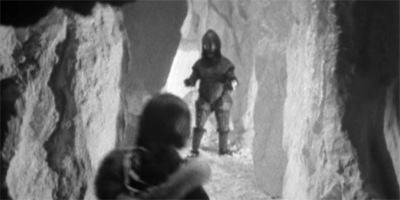


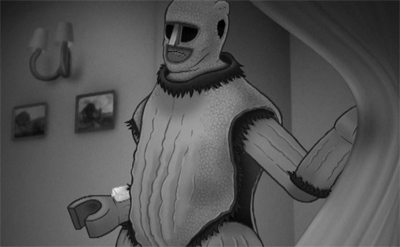

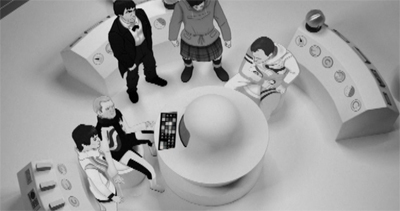
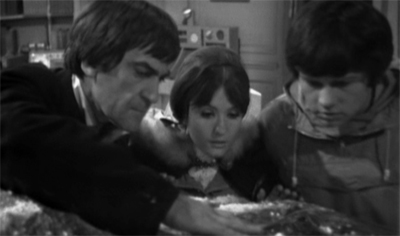

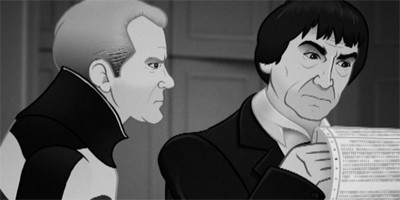
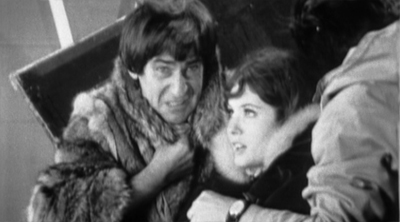






Leave a comment